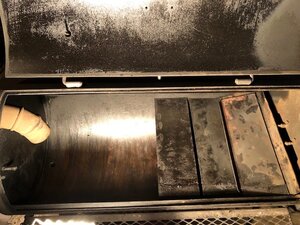What's the consensus on tuning plates ?
Not many smoker builders sell their units with tuning plates. The only one I know of is LSG's 24" pipe smokers. They include tuning plates with instructions on where to place them.
If ya can't tell, I'm on the fence with them. I think they can evenly distribute heat, but they can also influence flavor with the smoke created by juices dripping on hot metal, much like a reverse flow.
They can also restrict air flow, but more and more I'm coming to the opinion that air flow is not important in a backyard cooker. Yeah, on a 14 foot long , 1000 gal propane tank cooker, air flow is important. But I think most of these small smokers with 36 to 48" cook chamber , don't need a lot of air flow.
I'd been really proud of my Old Country Brazos, I thought I'd finally figured it out on getting even cooking temps end-to-end ......... and then I did a biscuit test and found out where my heat was at. The biscuits were done more thoroughly on the FireBox end of the grate, but not by much, even if my temp gauge said the temps were even. But then I turned the biscuits over ........ and the ones close to the FB were far more done.
Anyway, I'm thinkin about tuning plates. Welcome all opinion ?
Not many smoker builders sell their units with tuning plates. The only one I know of is LSG's 24" pipe smokers. They include tuning plates with instructions on where to place them.
If ya can't tell, I'm on the fence with them. I think they can evenly distribute heat, but they can also influence flavor with the smoke created by juices dripping on hot metal, much like a reverse flow.
They can also restrict air flow, but more and more I'm coming to the opinion that air flow is not important in a backyard cooker. Yeah, on a 14 foot long , 1000 gal propane tank cooker, air flow is important. But I think most of these small smokers with 36 to 48" cook chamber , don't need a lot of air flow.
I'd been really proud of my Old Country Brazos, I thought I'd finally figured it out on getting even cooking temps end-to-end ......... and then I did a biscuit test and found out where my heat was at. The biscuits were done more thoroughly on the FireBox end of the grate, but not by much, even if my temp gauge said the temps were even. But then I turned the biscuits over ........ and the ones close to the FB were far more done.
Anyway, I'm thinkin about tuning plates. Welcome all opinion ?






